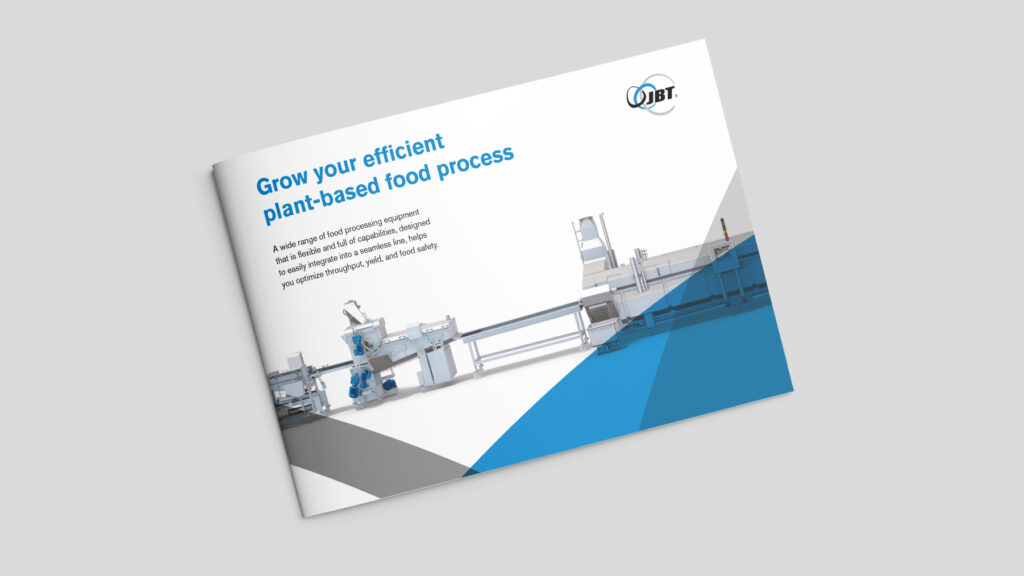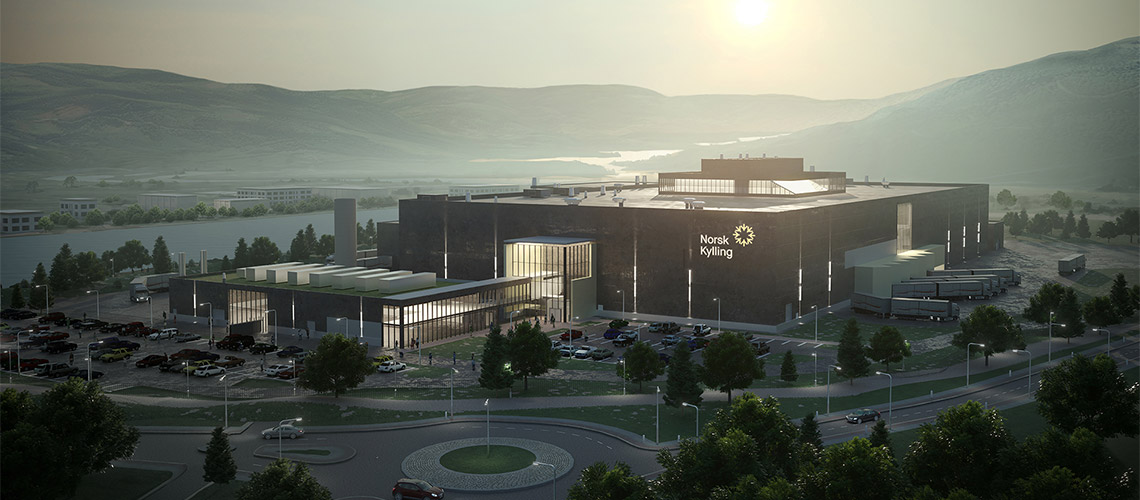When Norway’s leading poultry producer Norsk Kylling planned its new production facility, the goal was clear: They wanted to create a signature building for sustainable food production and Norwegian agriculture. But they also wanted all suppliers involved in the project to be committed and engaged in developing the industry further.
JBT had the food processing machines, experience, and innovation that measured up to the requirements and put together a dedicated team of experts that worked in close collaboration with Norsk Kylling. As an innovative part of the project, JBT redesigned their Stein® TwinDrum™ Spiral Oven so that it could use electric heat from renewable sources.
“We wanted to create one of the world’s most modern and efficient factories in terms of quality and logistics,” says Håvard Staverlökk, Project Leader of Norsk Kylling.
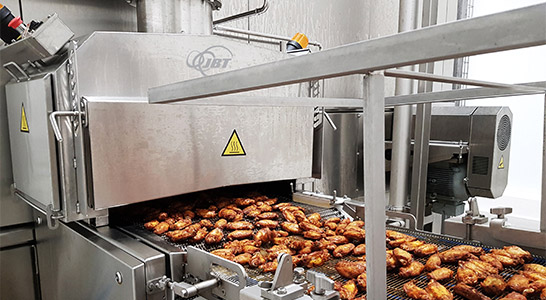
For Norsk Kylling, animal welfare is at the center. At the same time, they must ensure that production can meet the increasing demand for poultry products without it being at the expense of the climate and the environment. They work with circular thinking throughout the value chain, everything from what fodder the chicken eats to using the by-products from the slaughterhouse and taking advantage of biological diversity. In 2016, they began an extensive strategy work for their future development which, as a first step, led to them switching to another breed of chicken.
“We replaced Ross, our existing chicken breed, with Hubbard,” says Håvard Staverlökk. “The Hubbard chicken grows more slowly and has a healthier appetite and better health, contributing to better animal farming. In addition, it gives a better taste. The change was an essential part of our sustainability work.”
Early in the strategy work, it also became clear that several challenges were associated with the production facility. It was impossible to develop the existing factory to meet the sustainability standard required in the future, which led to the decision to build an entirely new one and the journey to find and select partners that could deliver machinery to meet the new standard.
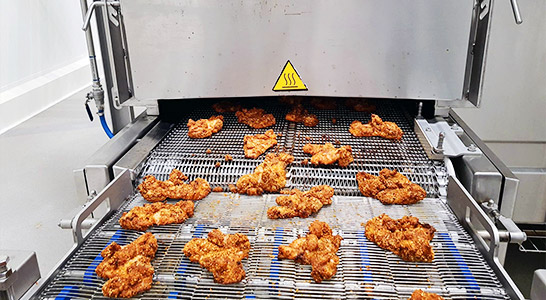
Energy-smart solutions at the center
The ambition with the new production facility was high in terms of sustainability. The goal was for it to be a model for other producers around the world when it comes to adapting to the energy systems of the future with increasingly unregulated power, such as solar and wind.
“Among other things, we invested in electrification and focused on energy flexibility, primarily through energy storage,” says Håvard Staverlökk. “The plant is built for zero emissions and uses only renewable energy, and we have reduced greenhouse gas emissions by 100 percent compared with our old factory.”
The factory has several intelligent systems for storing, controlling, and purchasing renewable energy. It uses thermal energy storage for heat, but a project is underway to develop the technology so that it can also store coldness. It obtains district heating from Elkem’s smelter on the other side of the Orkdalsfjord, whose waste heat covers the entire factory’s warming needs. Thanks to the pipeline, other factories and offices in the area can also reduce their need for electricity and fossil energy for heating.
“The pipeline results from a collaboration between local industries, energy companies, and the municipality,” says Håvard Staverlökk. “This type of cooperation is central to our ambition to be a driving force in the climate field. We have designed our environmentally friendly energy solutions so that they can share energy with other factories and offices to reduce the climate footprint further. Our ambition is for the entire area to have lower CO2 emissions than before we established ourselves here.”
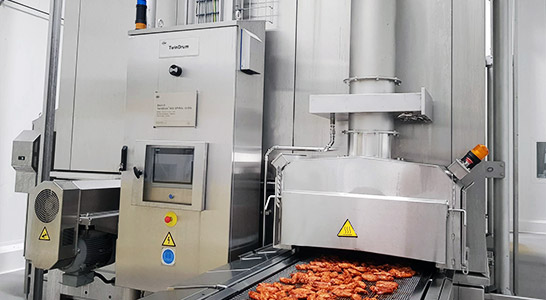
Sustainable production with a unique electric line
Norsk Kylling has a production that includes everything in the poultry segment, from producing fresh pieces to cooked products. At the further processing side of the new plant, JBT established two integrated, electric-fed production lines with one Stein M-fryer, two Stein TwinDrum Spiral Ovens, and two Frigoscandia GYRoCOMPACT® Spiral Freezers. However, the creative challenge was modifying the Stein TwinDrum Spiral Oven to use electric heat, says Erland Leide, R&D Manager at JBT.
“Production plants today often use ovens with thermofluidic heat transfer, which means that oil is heated with electricity or gas and then pumped around in loops. Norsk Kylling wanted an oven that used direct-acting electricity. The advantage of electric heating is that the efficiency is higher and the temperature control faster, which means the oven consumes less energy. They can access entirely fossil-free and renewable electricity, which makes it a sustainable solution.”
Even when JBT first developed the Stein TwinDrum Spiral Oven, they thought about using electricity as an alternative. However, the assessment was that the technical challenges of using electric power in hot and wet areas were significant. Therefore, it was initially designed only for heating by thermofluid. Based on Norsk Kylling’s extensive requirements specification, JBT modified its basic design, making it their largest electric oven in Europe.
“A challenge with using electricity for heating is the power requirement. There is a lot of high current energy that has to go into the oven”, says Erland Leide. “Thus, for example, eight thick cables were required to enter and feed the heating elements. In other electric heated ovens, the cables are run from the ceiling down to the hood where heating elements are located, making them move when it lifts, which we wanted to avoid. We designed a solution that made it possible to run the cables inside the oven instead. In this way, we kept them static and reduced wear and tear to increase service life and minimize maintenance.”
A developing collaboration for both parties
JBT had an ongoing dialogue with Norsk Kylling about where to locate the equipment, install the connection to the electrical system, and meet other requirements.
“We tailored the location of the control cabinets and the connection, but the solution for the oven itself is more standardized,” says Erland Leide. “Even when we originally designed the oven, we thought modularly, so there was no need for special adaptations. The collaboration with Norsk Kylling led us to develop the oven further as we adapted it based on their actual needs and input. Their detailed requirements specification and our dialogue gave us valuable information on how to develop our equipment better to meet our customers’ requirements and needs.”
Norsk Kylling had a clear vision for how they wanted the solutions to work. They also wanted everyone involved in the project to understand it, be committed, and develop the industry further. For them, JBT was a supplier who had the experience and food processing systems that could measure up to their requirements while at the same time being flexible and innovative enough to be able to deliver value to the project.
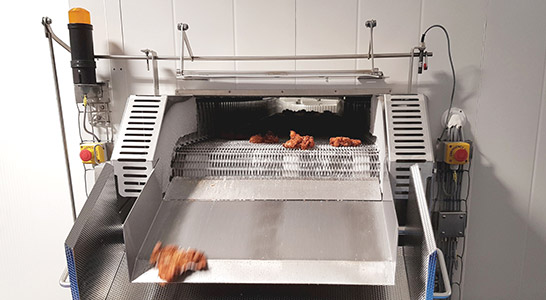
A partnership without prestige
To make sure the project would be as hassle-free as possible, JBT had set up a dedicated team that worked closely together with the team at Norsk Kylling, creating a personal yet professional relationship.
“During the whole installation and start-up phase, we were almost constantly at the site, which created a real team spirit and a lot of engagement,” says Teddy Svensson, Engineering Manager at JBT. “For us, the main focus is the customer. If there were any problems and we weren’t there, we immediately traveled up to Orkanger to solve it.”
It’s essential to focus on problem-solving to maintain a good relationship and create a successful project. “When we all work as a team without prestige, we can find the optimal solutions and learn from each other.” says Teddy Svensson.
JBT also helped Norsk Kylling develop recipes for the highest yields and trained its staff to use the CIP systems to optimize the water, detergent, and energy consumption.
“The collaboration with JBT has been perfect, although I think we sometimes both felt this was a demanding project,” says Håvard Staverlökk. “You have to acknowledge that there are challenges and find solutions together. I would say that both JBT and Norsk Kylling have taken turns solving our challenges in the project, and in this way, we have together managed to complete it in the best possible way.”
Are you interested in growing your business with JBT?
JBT is here for you! Contact your local sales office or fill out the form, and we will get in touch shortly.
